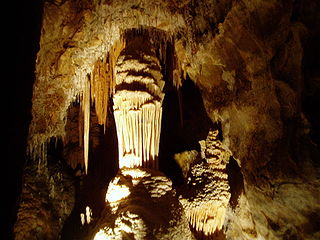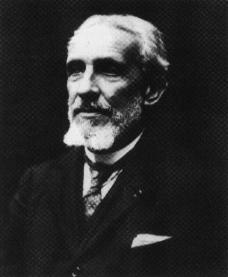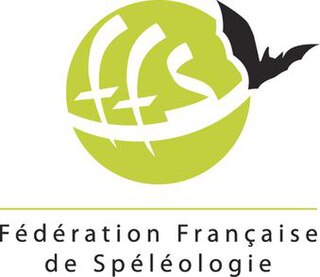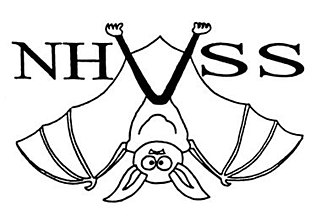The topic of this article may not meet Wikipedia's notability guidelines for companies and organizations .(March 2017) (Learn how and when to remove this template message) |
The Sydney Speleological Society Inc. (SSS) is a caving group based in Sydney, Australia. The Sydney Speleological Society was founded in 1954 and is one of the oldest caving groups in Australia. [1] The Sydney Speleological Society has organised caving expeditions both locally and internationally. The Sydney Speleological Society has participated in events regarding caving, caving standards, caving publications, caving equipment, caving safety, and cave rescue. [2] The Society also participated in the founding of the Australian Speleological Federation. [3]

Caving – also known as spelunking in the United States and Canada and potholing in the United Kingdom and Ireland – is the recreational pastime of exploring wild cave systems. In contrast, speleology is the scientific study of caves and the cave environment.
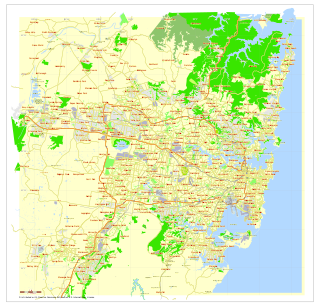
Sydney is the state capital of New South Wales and the most populous city in Australia and Oceania. Located on Australia's east coast, the metropolis surrounds Port Jackson and extends about 70 km (43.5 mi) on its periphery towards the Blue Mountains to the west, Hawkesbury to the north, the Royal National Park to the south and Macarthur to the south-west. Sydney is made up of 658 suburbs, 40 local government areas and 15 contiguous regions. Residents of the city are known as "Sydneysiders". As of June 2017, Sydney's estimated metropolitan population was 5,230,330 and is home to approximately 65% of the state's population.

Australia, officially the Commonwealth of Australia, is a sovereign country comprising the mainland of the Australian continent, the island of Tasmania, and numerous smaller islands. It is the largest country in Oceania and the world's sixth-largest country by total area. The neighbouring countries are Papua New Guinea, Indonesia, and East Timor to the north; the Solomon Islands and Vanuatu to the north-east; and New Zealand to the south-east. The population of 26 million is highly urbanised and heavily concentrated on the eastern seaboard. Australia's capital is Canberra, and its largest city is Sydney. The country's other major metropolitan areas are Melbourne, Brisbane, Perth, and Adelaide.
Contents
The Sydney Speleological Society has published many books on caving and caving areas in Australia and continues to work on many projects to further the understanding of caving and karst areas in Australia and overseas. These achievements have included developing communication and navigation equipment for caving, leading excavations of caves, mapping and indexing caves in Australia, and publishing articles about cave meteorology. [2]

Karst is a topography formed from the dissolution of soluble rocks such as limestone, dolomite, and gypsum. It is characterized by underground drainage systems with sinkholes and caves. It has also been documented for more weathering-resistant rocks, such as quartzite, given the right conditions. Subterranean drainage may limit surface water, with few to no rivers or lakes. However, in regions where the dissolved bedrock is covered or confined by one or more superimposed non-soluble rock strata, distinctive karst features may occur only at subsurface levels and can be totally missing above ground.

Meteorology is a branch of the atmospheric sciences which includes atmospheric chemistry and atmospheric physics, with a major focus on weather forecasting. The study of meteorology dates back millennia, though significant progress in meteorology did not occur until the 18th century. The 19th century saw modest progress in the field after weather observation networks were formed across broad regions. Prior attempts at prediction of weather depended on historical data. It was not until after the elucidation of the laws of physics and more particularly, the development of the computer, allowing for the automated solution of a great many equations that model the weather, in the latter half of the 20th century that significant breakthroughs in weather forecasting were achieved. An important domain of weather forecasting is marine weather forecasting as it relates to maritime and coastal safety, in which weather effects also include atmospheric interactions with large bodies of water.
The Sydney Speleological Society publishes a monthly journal that documents the many activities of the Society and caving in general. The Journal has been in continuous publication for over 50 years, making it one of the oldest continually published caving journals in Australia with over 630 editions. [4] This publication is a reputable source of information on many aspects of caving in Australia and overseas. [5]





